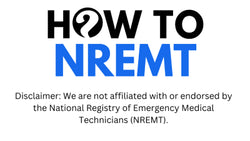Emergency Medical Responders (EMRs) play a critical role in the chain of prehospital care. From providing immediate life-saving interventions to stabilizing patients until more advanced providers arrive, EMRs must remain proficient and up to date in their skills. The recertification process for EMRs ensures they continue to meet national standards and maintain readiness to respond in emergencies.
The National Registry of Emergency Medical Technicians (NREMT) outlines specific pathways and requirements for recertification. This guide explores those pathways and provides a breakdown of the recertification requirements for EMRs.
Understanding EMR Recertification Pathways
EMRs certified through the NREMT must renew their credentials every two years. There are two primary pathways to maintain certification:
1. Recertification Through Continuing Education
2. Recertification by Examination
Pathway 1: Recertification Through Continuing Education
The most common and widely used method of recertification is through the completion of Continuing Education (CE) hours that align with the National Continued Competency Program (NCCP). EMRs are required to complete 16 hours of CE training under this model, which is divided into three main components:
National Component – 8 Hours
The National Component includes standardized topics identified as essential across all EMS roles. These topics are reviewed and updated based on national data, evidence-based guidelines, and stakeholder feedback.
Required content areas include:
● Airway, Respiration & Ventilation
● Cardiovascular Emergencies
● Trauma
● Medical (including OB/GYN and Pediatrics)
● EMS Operations
The 8 hours must be completed through courses delivered by NREMT-approved or state-approved educators, either in person or via accredited online platforms.
Local or State Component – 4 Hours
This component is tailored to regional or agency-specific needs. The state EMS office, training officer, or local medical director may determine topics based on trends, regional health concerns, or skill gaps. If local authorities do not outline requirements, EMRs may choose relevant EMS education topics to complete these hours.
Individual Component – 4 Hours
This portion offers flexibility for EMRs to focus on areas they wish to strengthen. These can include high-risk, low-frequency procedures, review of recent field cases, or subject matter areas where the responder may feel less confident.
Courses can be selected based on personal development needs and can include trauma scenarios, pediatric assessments, medical-legal ethics, or mental health care during EMS calls.

Pathway 2: Recertification by Examination
EMRs also have the option to recertify by taking the NREMT cognitive exam. This pathway is ideal for those who are confident in their clinical knowledge and want to renew their certification without completing CE hours.
Here’s how it works:
● Submit a recertification application through the NREMT website
● Choose the “Recertify by Exam” option
● Pay the exam fee (currently $98 for EMRs)
● Receive an Authorization to Test (ATT)
● Schedule and complete the computer-based cognitive exam at a Pearson VUE testing center
● Pass the exam before your certification expiration date
This pathway satisfies all recertification requirements in one step but may not be suitable for those who prefer ongoing education and training reinforcement.
Required Credentials and Documentation
To successfully complete recertification through continuing education, EMRs must ensure they meet the following prerequisites and submit all required documentation.
Checklist for Recertification:
● Current NREMT EMR certification (not expired)
● A minimum of 16 CE hours (as per NCCP guidelines)
● Valid CPR certification for healthcare providers (e.g., AHA BLS)
● Completion of the online recertification application via the NREMT portal
● Verification of skills competency by an approved training officer, instructor, or medical director
● Payment of the recertification fee (typically $20–$25, depending on the state or agency)
All CE training must be completed within the current certification cycle and verified prior to submission.
Accepted Continuing Education Sources
CE hours can be completed through a variety of platforms, provided they meet quality standards. The NREMT accepts CE from the following:
● State-approved EMS refresher courses
● CAPCE-accredited online courses
● College or university-level EMS education
● Hospital or in-service training
● Medical conferences or workshops
● Instructor-led practical training
All content must be relevant to EMS practice and be presented by qualified educators. Many EMRs find online courses convenient and cost-effective, especially those offered by platforms that specialize in EMR and EMT continuing education.
What Does Not Count Toward CE Hours?
Some activities do not meet the standards set by the NREMT and will not count toward your recertification total:
● Duplicate courses completed more than once during the same cycle
● CPR certification (although required, it does not count toward the 16 CE hours)
● Clinical ride-alongs or patient care hours
● General college courses not related to EMS
● Instructor or educator development training (unless directly tied to EMS education)
It's important to review course content and accreditation before enrolling to ensure the hours will be accepted.
Maintaining and Tracking CE Records
EMRs are responsible for maintaining clear records of all CE activities completed. These should include:
● Course name and provider
● Instructor name
● Date of completion
● Number of approved CE hours
● Proof of completion (certificate or transcript)
It is recommended to store CE records digitally and back them up in case of a random audit by the NREMT. Audit requests can be issued during the recertification review, and failure to provide proper documentation can result in certification denial.
Tools like CE tracking spreadsheets or online credential management portals can help you stay organized.

Important Recertification Deadlines
Recertification is based on a two-year cycle. Here are the key deadlines:
● October 1 – Recertification application period opens
● March 31 – Application deadline (must be submitted and verified)
● April 1–30 – Late submission window (may incur additional fees)
● May 1 – Certification expires if recertification is not completed
EMRs are strongly encouraged to begin their CE hours and application process well before the March 31 deadline to avoid issues with verification or documentation.
Staying current with recertification requirements for EMR is a vital responsibility for every Emergency Medical Responder. With just 16 hours of CE and proper planning, you can ensure your credentials remain active and avoid the stress of last-minute scrambling.
Explore our NREMT exam prep platform, expert-led tutoring, and focused study resources at How To NREMT—your trusted destination. Contact us for details.

